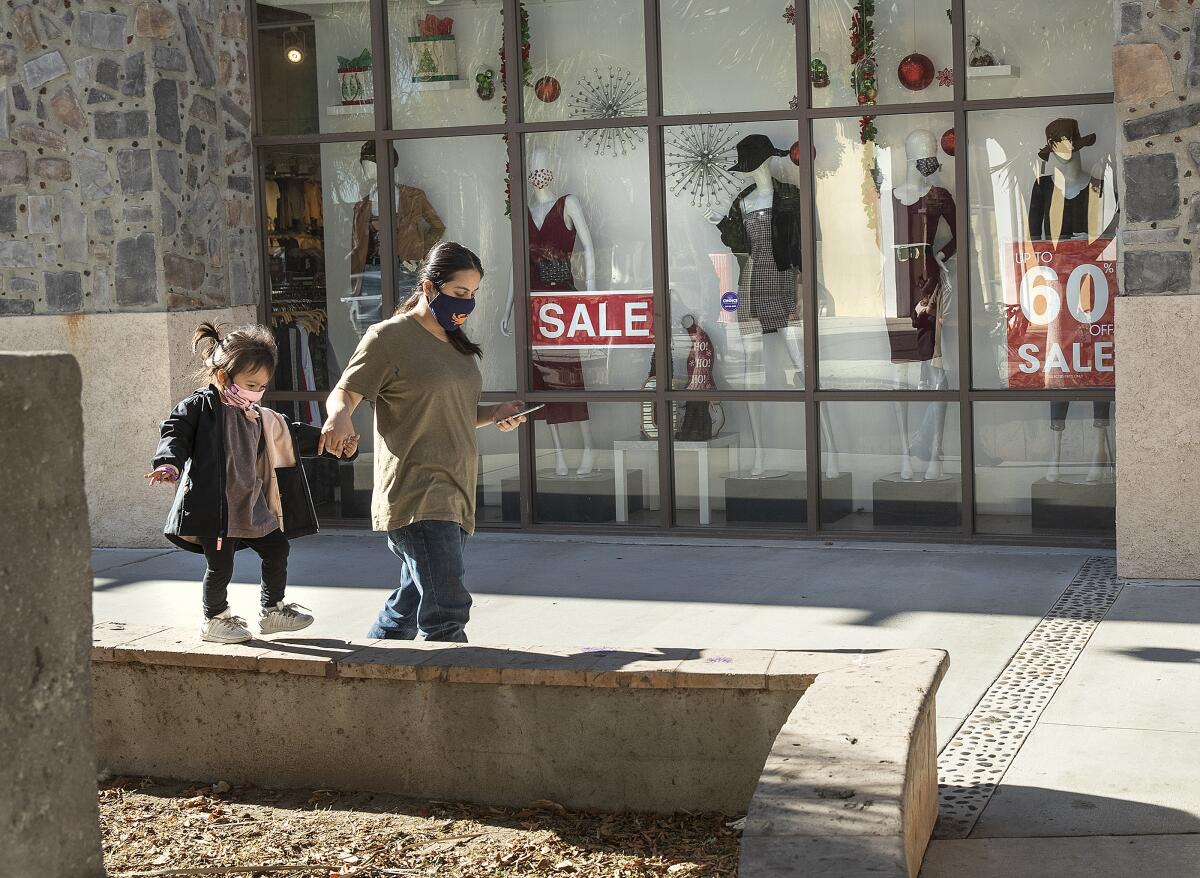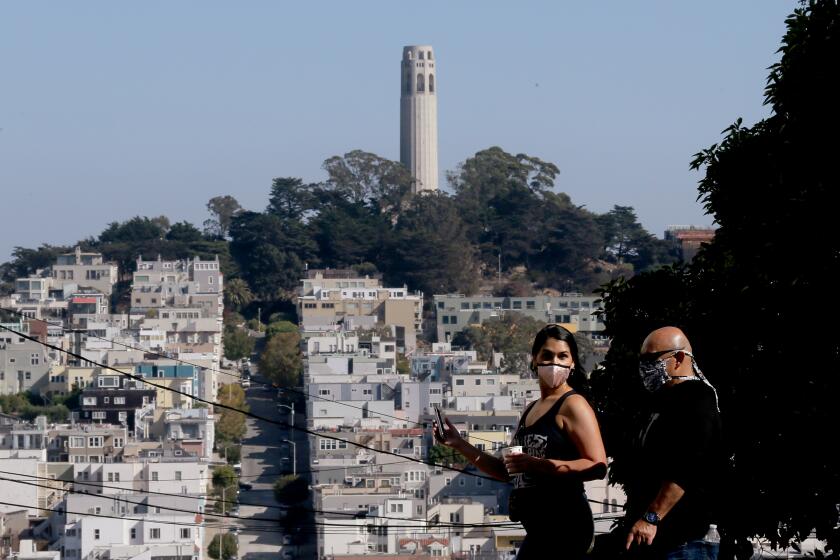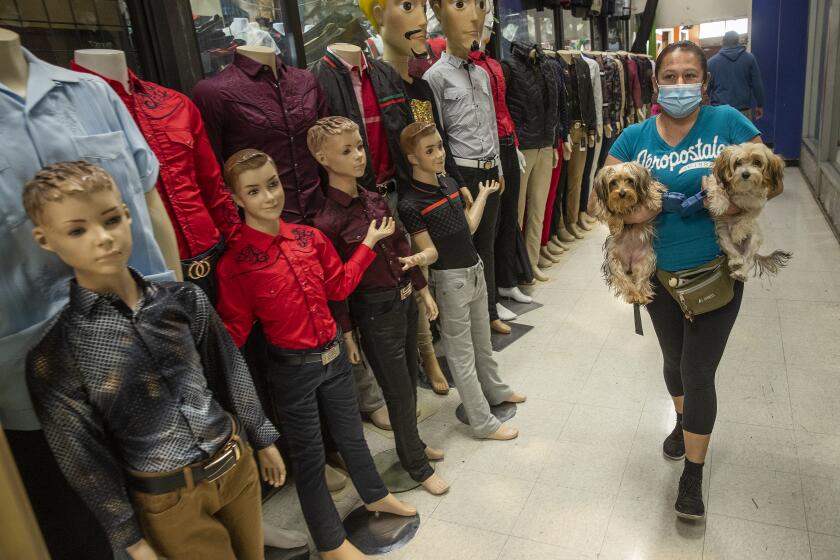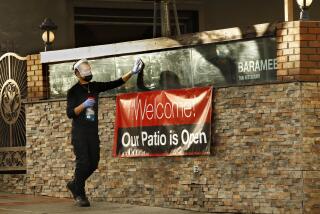Lockdowns are depressing and economically devastating. But California might not have a choice

- Share via
Stay-at-home orders are increasingly unpopular, wreak havoc on the economy and leave some people feeling even more isolated and depressed.
But as California careens toward the most dangerous surge of the COVID-19 pandemic, many public health experts say the orders may well be the best — and possibly the only — way to slow the rapid spread of the virus.
Gov. Gavin Newsom’s latest stay-at-home order has faced criticism from all sides, with some saying it’s too restrictive and will kill small businesses, while others question whether the rules are tough enough, wondering why malls will be allowed to stay open.
Experts said the coronavirus is now spreading so quickly across the state and hospitalizations are soaring so fast that the time for incremental measures has passed, and the most effective way to bend the curve is to keep people home as much as possible.
Nuance can work in public health strategies, but sometimes “when you take a more nuanced approach — what’s OK and what’s not OK — that makes people more confused,” said Dr. Shruti Gohil, associate medical director of epidemiology and infection prevention at UC Irvine. “By unilaterally closing everything down, you do send the psychological message ... that we ought to stay home; that now’s the time to hunker down again. And that could save lives.”
Other parts of the world have been able to curb new surges with aggressive action.
When Europe saw a severe spike this fall, governments were forced to end an incremental approach and responded with swift lockdowns that turned the tide in just a few weeks.
France — which observed a quadrupling of daily coronavirus cases over October — decided to enact strong measures to deal with its second wave: imposing a broader curfew, from 9 p.m. to 6 a.m., in the bigger cities; ordering the shutdown of nonessential businesses such as retail stores, restaurants and bars; making masks mandatory for anyone age 6 and older; and banning travel, including to second homes.
“It suggests that these kinds of measures are met with fairly rapid success, like within a couple of weeks,” said Dr. George Rutherford, epidemiologist and infectious diseases expert at UC San Francisco.
In fact, some parts of California are now going a step further than Newsom. Five counties in the Bay Area on Friday said they would get a head start and implement Newsom’s stay-at-home order at the beginning of next week, declining to wait until the region’s increasingly crowded intensive care units fall below 15% of capacity, which is the state’s trigger for initiating the order.
“It should’ve taken effect a week ago, or maybe right now, like the Bay Area is doing. I think the longer we wait, the more trouble we’re going to be in,” said Dr. John Swartzberg, clinical professor emeritus of infectious diseases at the UC Berkeley School of Public Health. By waiting longer to enact the order in the rest of the state, “we may be out of ICU beds before the effects of the stay-at-home order really have a salutary effect.”
Southern California’s intensive-care bed shortage entered the zone Friday night that, if it persists, would trigger the state’s stay-at-home order as early as Sunday. On Friday night, the California Department of Public Health released new numbers showing that Southern California as well as the San Joaquin Valley now face a critical shortage of ICU beds, with each area having less than 15% of its capacity available.
Once an order takes effect, it can take roughly two to three weeks before the effect is seen in intensive care units, as it generally takes that long before someone who is exposed to the virus becomes sick enough to need the ICU.
A stay-at-home order now would help California avoid plunging into a historic crisis that would leave the state’s intensive care units overwhelmed to a point never seen before in modern state history.
Not only would COVID-19 patients suffer from getting care from overwhelmed nurses and doctors, but so would victims of strokes, heart attacks and car crashes.
“Today we had 22,000 cases, yesterday we had 18,700,” Dr. Mark Ghaly, the California Health and Human Services secretary, said Friday in an interview. “At these levels ... it tells you that the hospitals in just two weeks are going to be much more impacted than they are now.”
Some other countries have been able to avoid the painful shutdowns California is enduring. That’s because they were far more successful in controlling the virus.
If ICU bed capacity stays below 15%, a regional stay-at-home order would kick in, shutting outdoor restaurant dining, hair salons, nail salons, playgrounds, cardrooms, museums, zoos, aquariums and wineries and restricting retail capacity to 20%.
Taiwan has a death toll of just seven from the coronavirus, but never had to shut down broad swaths of the economy in part because officials instituted severe travel restrictions quickly and enforced strict quarantines, carefully monitoring anyone coming into the country.
Japan has about one-tenth of California’s death toll despite having more than triple the state’s population. One reason is likely the nation’s adherence to universal mask wearing.
By contrast, the U.S. has arguably the world’s worst record in handling the pandemic. The U.S. has 4% of the world’s population but has 18% of COVID-19 deaths. The death toll of more than 279,000 is the worst of any nation worldwide.
“One of the great failures in the U.S. is that we have this piecemeal patchwork set of responses, and that clearly does not work,” said Dr. Kirsten Bibbins-Domingo, chair of UC San Francisco’s department of epidemiology and biostatistics.
Among the missteps: Political fights over wearing masks, both nationwide and in California, and a shoddy public health infrastructure, ill-equipped to enforce quarantines on arriving travelers.
Bay Area health officials have issued a stay-at-home order effective Sunday, fearing that COVID-19 patients could otherwise overwhelm hospitals.
“What makes this crisis particularly dangerous to the U.S. is that we continue to have polarization and we really have not had the type of infrastructure investment in testing, tracing — all those things we would expect for a country like ours,” Bibbins-Domingo said.
The lack of ongoing substantial federal economic aid to businesses and workers suffering from pandemic restrictions has also played a role in fueling the latest outrage against new stay-at-home orders. Economic shutdowns would be far more tolerable if the federal government were providing the kind of checks issued in the first wave of the pandemic.
Countries in Europe, by contrast, have much stronger social safety nets for people who get sick and those who lose work due to shutdowns, lessening the blow to the general public.
It’s clear the restrictions are facing more pushback in Los Angeles County. Parents have expressed outrage at playgrounds closing while retail businesses remain open. The suspension of outdoor dining in L.A. County brought a lawsuit and protest, with owners and customers saying they were being unfairly targeted without clear evidence that eateries were spreading COVID.
High-profile incidents in which some of California’s top politicians dined with people outside their household at fancy restaurants while talking about the dangers have only fueled more skepticism and anger.
But many experts say the dangers are real.
“When you have widespread community transmission — as we are experiencing in this viral tsunami we now have — every place has to have control measures,” said Dr. Robert Kim-Farley, medical epidemiologist and infectious diseases expert at the UCLA Fielding School of Public Health. “At this stage, with this sharp increase in cases, basically all places are potentially at higher risk of transmissions.”
Playgrounds had been shut since the early days of the pandemic in March and only began to reopen in late September. Since then, however, it’s become clear that kids and adults from different households still get pretty close to one another at a play structure, and some don’t wear masks, Ghaly said, even though that’s a requirement for those age 2 or older.
In addition, there’s no real way to enforce a capacity limit at many playgrounds, said Kate Folmar, a spokeswoman for the California Health and Human Services Agency.
One exception to the new stay-at-home order involves allowing nonessential retail stores, including malls, to remain open, albeit at a capacity of just 20%.
The new order requires Californians to stay home and minimize their interactions with other households as much as possible.
A big reason for that decision was what state officials observed in the spring. With only certain stores, like those selling groceries, allowed open, that largely left only big-box stores open — and shoppers flocked there, resulting in long lines outside, and it was difficult for store employees to keep customers physically distanced as they waited, Ghaly said.
“So the concept of having a broader range of places to be able to go — and sort of reduce the density in any one of these retail outlets — was the idea around keeping a broad swath of the retail sector open under this order,” Ghaly said.
In fact, it’s possible that a big-box store at 20% capacity is less risky than a small hair salon, given that — if everyone is following the rules — people are more than six feet from each other, the ventilation might be better, and they are spending less time in close contact with other people, Bibbins-Domingo said.
More to Read
Sign up for Essential California
The most important California stories and recommendations in your inbox every morning.
You may occasionally receive promotional content from the Los Angeles Times.















